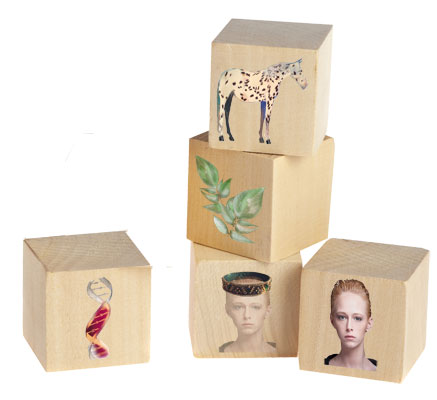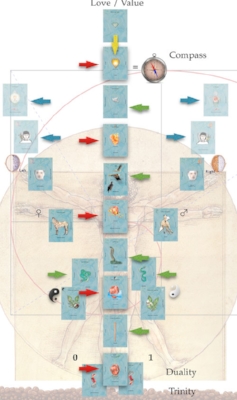InnerDialogue™ is the work of Solihin and Alicia Thom
This work emerged as a blending of emanation philosophical traditions and decades of clinical practice.
Seeded from Neoplatonism, Early [Augustine] Christianity, Eastern Orthodoxy, and the writings of Gregory Palamas, [Lurianic] Qabalah and Islamic [Ibn Sina, Al Farabi] exegesis, Tomas Aquinas, St Theresa and later in modern interpretations through visionaries such as Bohm, Schumacher, Graves, and Wilber. The origins of the work come from a long-held perennial philosophy called The Great of Being.
Emanation [literally ‘dripping‘] philosophies suggest our being consists of the overflow from the essence of God.
InnerDialogue™ presents a human template model, similar to the emanations who noted that we contain levels of being or lower aspects of self [Arabic nafs]: for within each human, lies elements of our phylogenetic past. These may be named as our material, vegetal, animal, and human selves. When we view a human being, we do not see these phylogenetic bits but merely see them as a fellow human. Observing their corporeal body, we may note their symmetry or otherwise, overall shape, physiognomy, and sex, and reflect on their general well-being. People normally appear to be relatively congruent and illustrate the countless variations that all living things exhibit. However within this matrix or material body lie hierarchical elements whose material nature prohibits any change or altered position within a supposed hierarchy of function, but these elements influence alters when they occupy a change of place. These interior elements may be disarranged, altered, undifferentiated: and consequently alter our physiology, neurology, psyches. Furthermore, their new or dominant arrangement may make it difficult to find meaning and purpose in their life. This core understanding underlies the work of InnerDialogue utilized by practitioners and taught around the world.
“The important notion however, is that we, unless trained, do not see this change of position; as outwardly everything appears as if normal.”
The internal rank or order has been altered or not developed
The understanding of what InnerDialogue is did not arrive out of the blue. Although we have now a very precise ontological exegesis, its inception evolved out of Osteopathic medicine, and in particular cranial osteopathy (after William Garner Sutherland DO). Thoughts and philosophy gleaned from TCM (Traditional Chinese Medicine), homeopathy, epigenetics, clinical biochemistry, and nourishment are incorporated into the work. By adding kinesiology (neurokinetic feedback) and mudras–as a communication language–the gradual evolution of a coherent ontology began to emerge over the late eighties and early nineties. [See ontological kinesiology ]
Ontological Kinesiology brought InnerDialogue into its present form, through the initial tutelage of Brian Butler (UK), Dr Meldener (Fr), Dr John Bandy (US), and Dr Alan Beardall (US) who were all instrumental in Solihin’s introduction into kinesiology as a tool for dialogue.
Five elements have been brought into this work.
-
Mudras are used as a coherent language (gestures are a proto-language).
-
Kinesiology as a neurokinetic reflexive feedback tool.
-
The ground substance came from clinical practice and the ‘what’s wrong’ approach, and all of this was amalgamated into the
-
emanation ideas of levels of function or being. The work became
-
ontological in bias, as we started to look at the root cause that created the state rather than being. The work is structured upon the notion of the four elements that comprise the ordinary human, a fifth that suggests our potential as a Noble creature, and the four bridges of particular human (structural, physiological, action-reaction, psychological) and otherwise (ethical, moral, spiritual) qualities that augment a re-ordering, widening and transformative, information-filled state of being; an integration of these four elements into a congruent whole.
Solihin’s approach has been directed at observing the neurological inaccuracies within the science and art of kinesiology. Viewed as a flawed system, InnerDialogue™ and its sophisticated protocol(s) view the body displays as error-prone, due to its inbuilt reflexive protective or survival-based mechanisms. These sophisticated reflexive adaptive, flexible neurological responses can make muscle testing inaccurate, yet in its inaccuracy, the practitioner learns to read the information in a positive light rather than the negative. It allows the inherent vagaries of muscle testing to be used effectively as part of the dialogue. The present form of InnerDialogue is a sophisticated approach to counter the innate inaccuracies.
InnerDialogue has had many different incarnations, as the combined work was received and seeded and then slowly developed in the mid-eighties within the confines of osteopathic clinical practice. It was first taught as an add-on within Clinical Kinesiology, the brainchild of Dr. Alan Beardall DC, whose own work had emerged and further developed from Dr. Goodheart DC and his genesis of Applied Kinesiology.
It was first taught in Austria, as Ontological Kinesiology, then in the UK followed by the US as Opening Human Potential (OHP), and then modified in name only, as Restoring the Potential, when we discovered the same name (OHP) in use, by another unrelated practitioner. As the work evolved, it moved slowly from a primarily therapeutic model–the physician does this–to an interactive inter-dependent dialogue approach. We called it Inner Natures Integration (INI). This was when we started to see that the work offered a rare chance for people to understand their internal architecture. Primarily, during this youthful time in its history, ID was still practitioner-biased in nature. Slowly, however, the work changed as we began to see that we were being caught by protocol and its inherent bias towards structured thinking, and an underlying left-brain approach.
The sheer number of hand modes–the language of InnerDialogue–allowed us to break away from this formalist approach, and begin to listen to and be guided by the client rather than the physician’s own bias or clinical understanding. Obviously, this inter-dependency infers cooperation between the two–practitioner and client–but the tone of the dialogue has really moved towards being guided by the silence of Grace and the narrative of the client, with questions placed there by the practitioner (through the use of mudras). We started to see that we had ourselves, moved, from practitioner to practitioner-companion.
The work has in its subtext and its historical past, huge volumes of information particular to osteopathy, meridian, and allergy therapy, teaching stories (of the underworld, fairy, fable, myths, and odysseys), spiritual models and accompanying states, and much more. It has a huge database (over 4500 pages available on disc) that allows the practitioner-companion to widen the map even further, by being able to cross-check and access nuances from the modes that are relevant, so as not to be held on a track of inquiry but to be able to go off tangentially so that unexpected nuances of the story unfold.
InnerDialogue encourages a narrative to arise from the client. Our narratives or dominant story can be illustrated as a spiral. They are the unfolding of an Explicate Reality–and itemized in either stark terms (detail-orientated, and coming from our rational brain) or in a meandering, colorful, whimsical-often colorful story. (The spiral can also be seen as flexibility or the ‘snake’). We emerge from an Implicate Reality (illustrated by the integer or the One), which in Bohmian terms could be summed up as the Mind of God that penetrates everything.
The ‘snake’ of the caduceus, the old healing symbol, is an emblem of the Explicate, a life that unfolds and emerges out of the Implicate. It represents movement, animation, life and her temptations, blind ends, stagnation or stasis, unpredictability, a change of circumstances, travails, bite, poison, strangulation, shedding, transformation, and healing. It represents our innate need to survive, eat, digest, mate, ascend or descend from the tree of life, and can move horizontally across the ground, or burrow downwards into the deep, our unconscious or underworld, and may even be the instrument to tempt other’s or oneself with a forbidden apple.
The spiral without integrity
The spiral can metaphorically move across landscapes, be destructive, take us up into the air, or pick us up and deposit us, like the girl in the yellow brick road, in some other fantasy. So in our work, we have placed huge emphasis on the quiet state of the practitioner and the client. Quiet as in surrender; quiet as in open, quiet as in directed, quiet as in waiting, expectant but without need. Surrender is a loaded word in our present-day cultures–for it may infer the bearded deity waiting, judging, and running the affairs of humans. In our understanding this is to step into The Great Life, the Mind of God as an Implicit Reality, as David Bohm would suggest. It doesn’t do away with our personal ideas of the Mystery but allows us to simply step into the flow of Grace that is present at all times. In this way, both practitioner and client are guided by that Presence.
The work has a closed systemic nature by its structure, and gradually we have attempted to move away from the physician-guided therapeutic input to an open system whereby we are guided simultaneously by the Implicate so that the client’s narrative can unfold as the most direct and truthful. We recognize that even in those circumstances there will be practitioners who will still guide the process, and to some extent narrow the narrative into their own zone of comfort. This is because the client will accept the conversation that is, rather than what ought to be. Grace can be bypassed, the adventure retained or confined to the corral of our smaller minds. Nevertheless, we have experienced that even so, the work of InnerDialogue is so profound, the narrative so often accurate, and the outcome so extraordinary, that these shortcomings should not deter those from seeing a practitioner-companion.



